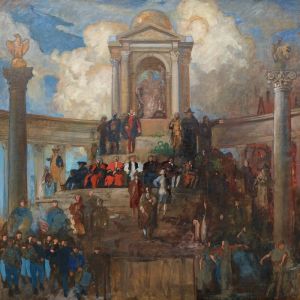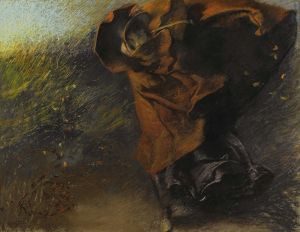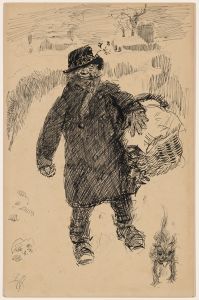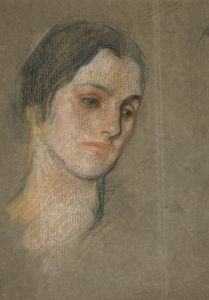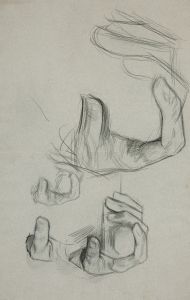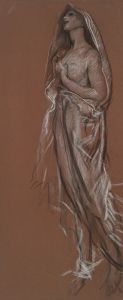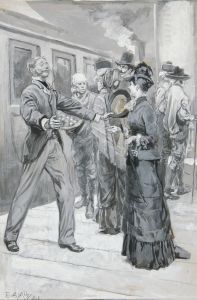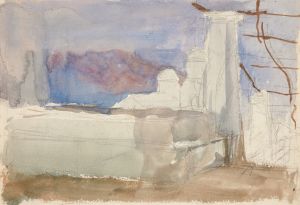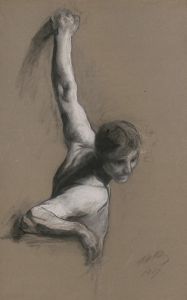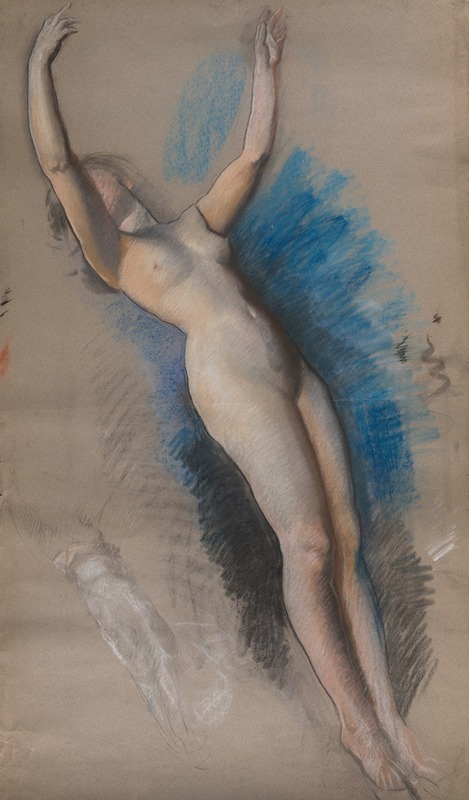
Figure study for ‘The Spirit of Light,’ lunette in the rotunda of the Pennsylvania State Capitol at Harrisburg
A hand-painted replica of Edwin Austin Abbey’s masterpiece Figure study for ‘The Spirit of Light,’ lunette in the rotunda of the Pennsylvania State Capitol at Harrisburg, meticulously crafted by professional artists to capture the true essence of the original. Each piece is created with museum-quality canvas and rare mineral pigments, carefully painted by experienced artists with delicate brushstrokes and rich, layered colors to perfectly recreate the texture of the original artwork. Unlike machine-printed reproductions, this hand-painted version brings the painting to life, infused with the artist’s emotions and skill in every stroke. Whether for personal collection or home decoration, it instantly elevates the artistic atmosphere of any space.
"Figure Study for ‘The Spirit of Light,’ lunette in the rotunda of the Pennsylvania State Capitol at Harrisburg" is a preparatory work by the American artist Edwin Austin Abbey. Abbey, renowned for his murals and illustrations, was commissioned to create a series of murals for the Pennsylvania State Capitol in Harrisburg, a project that would become one of his most significant contributions to American public art.
The Pennsylvania State Capitol, completed in 1906, is an architectural masterpiece designed by Joseph Miller Huston. It features a grand rotunda adorned with murals and sculptures that celebrate the history and achievements of Pennsylvania. Edwin Austin Abbey was selected to create several murals for the Capitol, including the lunettes in the rotunda. These lunettes are semi-circular wall paintings that occupy the curved spaces beneath the dome.
"The Spirit of Light" is one of the lunettes Abbey created for the rotunda. This particular lunette is an allegorical representation, a common theme in Abbey's work, which often drew on historical and mythological subjects to convey deeper meanings. The figure study for this lunette would have been a preliminary drawing or painting, used by Abbey to plan the composition, poses, and details of the final mural.
Abbey's figure studies are highly valued for their meticulous detail and artistic quality. They provide insight into his creative process and the development of his larger works. In these studies, Abbey would experiment with different poses, expressions, and arrangements of figures to achieve the desired effect in the final mural. The figure study for "The Spirit of Light" likely features a central figure embodying the concept of light, surrounded by other elements that complement the theme.
Edwin Austin Abbey was born in 1852 in Philadelphia, Pennsylvania. He began his career as an illustrator for magazines and books, gaining recognition for his skillful and detailed drawings. Abbey later moved to England, where he became associated with the Pre-Raphaelite Brotherhood and continued to develop his style. His work on the Pennsylvania State Capitol murals was a significant undertaking, reflecting his mature style and mastery of large-scale compositions.
The murals in the Pennsylvania State Capitol, including "The Spirit of Light," are celebrated for their artistic excellence and historical significance. They contribute to the Capitol's status as a National Historic Landmark and a symbol of Pennsylvania's cultural heritage. Abbey's work remains an important part of American art history, and his figure studies are appreciated for their beauty and the insight they provide into his artistic process.
In summary, the figure study for "The Spirit of Light" is a preparatory work by Edwin Austin Abbey for one of the lunettes in the rotunda of the Pennsylvania State Capitol. It exemplifies Abbey's skill in creating allegorical compositions and his meticulous approach to mural painting. The study is an important piece of art in its own right, offering a glimpse into the creative process behind one of Abbey's significant public artworks.






